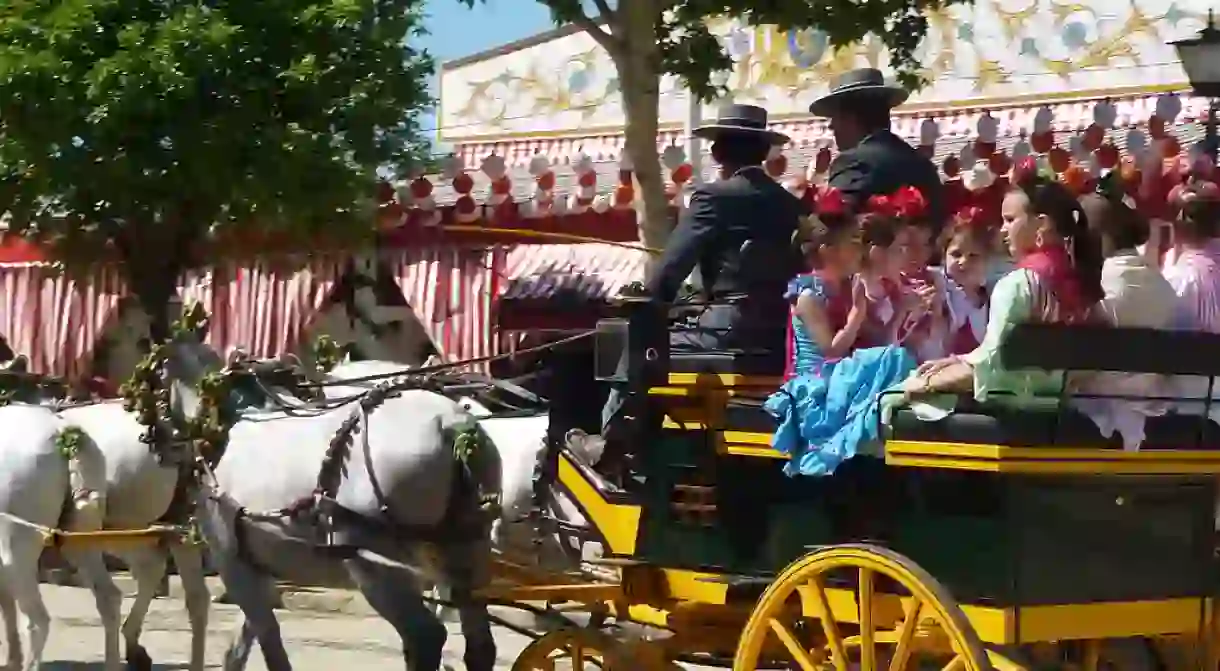A Guide to Seville's Feria de Abril, Andalusia's Biggest Festival

Every year, two weeks after the end of Holy Week, Seville kick-starts Andalusia’s high-octane feria season with its great Feria de Abril – a week-long extravaganza of dancing, non-stop socialising, eating, drinking and bullfights.
The modern-day feria, situated on an enormous fairground a little way out of Seville’s centre, came from humble beginnings. As befits a region steeped in agriculture and the breeding of livestock, a small cattle fair on the outskirts of Seville, started in 1847, was the rustic ancestor of today’s sprawling Feria de Abril.
To serve farmers trading at the cattle market and to provide those visiting with a drink and a bite to eat, three marquees were set up in 1848. The cattle fair slowly grew in popularity as a social event, so the number of these marquees, or casetas, multiplied year after year and by the 1920s the Feria de Abril had achieved something like its present size. Still it grew, and by 1973 the fair had to move to its present location – opposite the lovely Parque de María Luisa – to accommodate the number of casetas and visitors.

Now, over 1,000 of these party marquees crowd the recinto – the vast, sanded fairground. They are run by Sevillano businesses, collectives, political parties, families and charities and, unlike at every other Andalusian feria, the vast majority of them are private. Visitors not in possession of invitations to these exclusive social gatherings can hang out in one of the several public casetas.
These joyful, noisy and colourful marquees are entirely dedicated to the pursuit of pleasure. Walk up to their makeshift bars, be prepared to shout to make yourself heard over the music and crowds, and order the Feria de Abril’s signature drink – a rebujito. As will become clear the next morning, this delicious mixture of manzanilla (chamomile) sherry and lemonade is more potent than it tastes, but feria is unthinkable without it.

Rebujito in hand, you can watch the celebrations unfold. To the hypnotic rhythms of the Sevillanas – a dance closely related to flamenco but much more accessible – women, attired in their beautiful flamenco dresses, transform casetas into impressionistic canvases of colour and movement. Medieval-style feasts are prepared over huge, glowing pits of charcoal and enormous groups of friends and families enjoy never-ending lunches at wooden trestle tables. At Seville’s feria, there is something to seduce every sense.

In addition to seeing and being seen on the recinto, the other great social event of the feria – while also controversial – is the bullfighting festival. Along with the San Isidro fair in Madrid in May, Seville’s Feria de Abril hosts the best bullfights of the season. These are huge social occasions and locals pack out the 12,000-capacity arena every day of the feria, dressed in their finest attire, smoking cigars and enjoying giant picnics. Events are watched in the ring in studious silence, which is only broken at moments of great drama. Not for nothing are audiences in Seville said to be the most demanding in the bullfighting world.
The essence of this event, though, is the life that unfolds on the recinto and in the casetas. As big and famous as it is now, Seville’s fair is, as it is always has been, a very intimate celebration of family and friendship.













